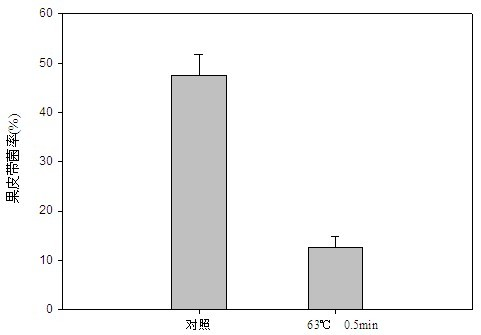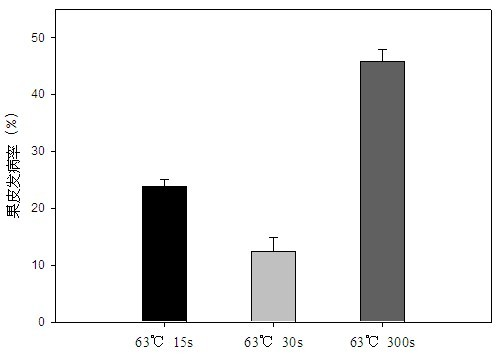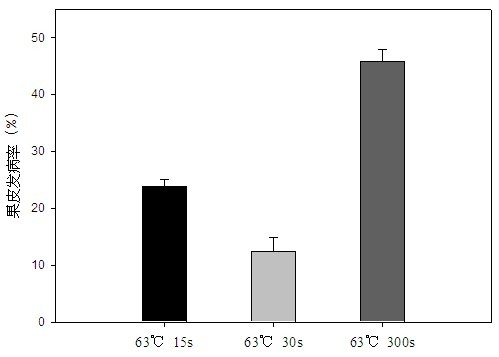Method for keeping papayas fresh
A fresh-keeping method and papaya technology, which are applied in the directions of fruit and vegetable preservation, food preservation, heating preservation of fruits/vegetables, etc., can solve the problems of long heat treatment time, low work efficiency, and great influence on the nutritional flavor of papaya, and achieve bacteriostasis. Wide range, high food safety, effects of optimized heat treatment steps and conditions
- Summary
- Abstract
- Description
- Claims
- Application Information
AI Technical Summary
Problems solved by technology
Method used
Image
Examples
Embodiment 1
[0024] (1) Select papaya fruits with uniform size, uniform maturity and no mechanical damage;
[0025] (2) Treat the fruit described in step (1) with ① soaking in hot water at 50°C for 15 minutes; ② soaking in hot water at 60°C for 60 seconds (s); ③ soaking in hot water at 63°C for 30 seconds; second;
[0026] (3) Place the fruit soaked in hot water in step (2) in a ventilated place and let it cool naturally for 1 to 2 hours.
[0027] Store the above-mentioned treated fruits at room temperature (25±1°C), take the fruits that have not been soaked in hot water as a control, and observe the anthracnose disease index every day, as shown in Table 1; fruit hardness, soluble solids and vitamins C content, as shown in Table 2.
[0028] Table 1 Control effect of heat treatment on papaya fruit anthracnose (25℃)
[0029]
[0030] Table 2. Effects of heat treatment on quality parameters of papaya fruit (25°C)
[0031]
[0032] Note: 1. The data in the table are the average of 3 ...
Embodiment 2
[0037] (1) Select papaya fruits with uniform size, uniform maturity and no mechanical damage;
[0038] (2) The fruits described in step (1) were soaked in ①.50°C hot water for 15 minutes; ②.60°C hot water soaked for 60 seconds (s); ③.63°C hot water soaked for 30 seconds; ④ . Soak in hot water at 65℃ for 15 seconds;
[0039] (3) Place the fruit soaked in hot water in step (2) in a ventilated place and let it cool naturally for 1-2 hours.
[0040] Store the above-mentioned fruits at room temperature (25±1°C), and use the fruits without heat treatment as a control to investigate the pedicle rot diseases of the above four combinations, as shown in Table 3.
[0041] Table 3 Control effect of heat treatment on papaya fruit stem rot (25℃)
[0042]
[0043] Note: 1. The data in the table are the average of 3 repetitions;
[0044] 2. Duncan’s test, the mean of the same column marked with the same letter in the table indicates no significant difference at the 0.05 level.
[0045]...
Embodiment 3
[0047] Choose papaya fruits with uniform size, uniform maturity, and no mechanical damage. The maturity of papaya fruit is that there are about 1 to 2 light yellow stripes on the surface of the peel (commonly known as "first-line yellow" or "second-line yellow"). Fruits with mechanical injuries and no pests and diseases; soak in hot water at 50°C for 15 minutes and hot water at 63°C for 30 seconds, place in a ventilated place, cool naturally for 1-2 hours, and then store at room temperature (25°C±1°C). Taking the fruit without heat treatment as a control, samples were taken every day to determine the change of the fruit belt bacteria rate, and the results are shown in the attached figure 1 shown. Compared with the control group treated at 63℃ for 30s, the rate of fruit belt fungus was 12.5%, while that of the control fruit was 47.5%. The rate of fruit belt bacteria treated by soaking in hot water at 50℃ for 15 minutes was 12.45%. about 3 times lower than the control. Obviou...
PUM
| Property | Measurement | Unit |
|---|---|---|
| Hardness | aaaaa | aaaaa |
Abstract
Description
Claims
Application Information
 Login to View More
Login to View More - R&D
- Intellectual Property
- Life Sciences
- Materials
- Tech Scout
- Unparalleled Data Quality
- Higher Quality Content
- 60% Fewer Hallucinations
Browse by: Latest US Patents, China's latest patents, Technical Efficacy Thesaurus, Application Domain, Technology Topic, Popular Technical Reports.
© 2025 PatSnap. All rights reserved.Legal|Privacy policy|Modern Slavery Act Transparency Statement|Sitemap|About US| Contact US: help@patsnap.com



